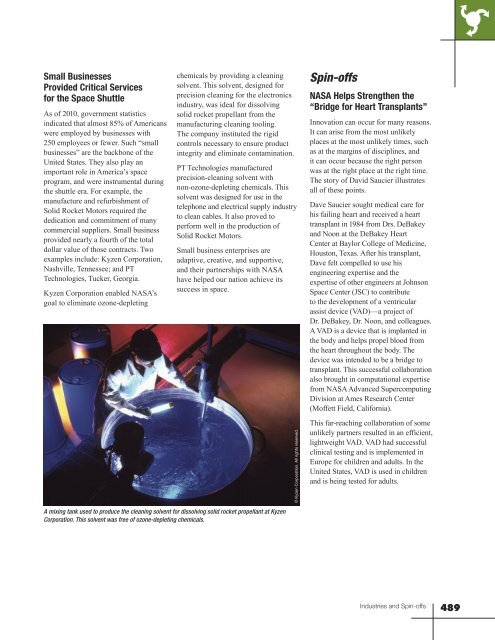Social, Cultural and Educational Legacies - ER - NASA
Social, Cultural and Educational Legacies - ER - NASA
Social, Cultural and Educational Legacies - ER - NASA
You also want an ePaper? Increase the reach of your titles
YUMPU automatically turns print PDFs into web optimized ePapers that Google loves.
Small BusinessesProvided Critical Servicesfor the Space ShuttleAs of 2010, government statisticsindicated that almost 85% of Americanswere employed by businesses with250 employees or fewer. Such “smallbusinesses” are the backbone of theUnited States. They also play animportant role in America’s spaceprogram, <strong>and</strong> were instrumental duringthe shuttle era. For example, themanufacture <strong>and</strong> refurbishment ofSolid Rocket Motors required thededication <strong>and</strong> commitment of manycommercial suppliers. Small businessprovided nearly a fourth of the totaldollar value of those contracts. Twoexamples include: Kyzen Corporation,Nashville, Tennessee; <strong>and</strong> PTTechnologies, Tucker, Georgia.Kyzen Corporation enabled <strong>NASA</strong>’sgoal to eliminate ozone-depletingchemicals by providing a cleaningsolvent. This solvent, designed forprecision cleaning for the electronicsindustry, was ideal for dissolvingsolid rocket propellant from themanufacturing cleaning tooling.The company instituted the rigidcontrols necessary to ensure productintegrity <strong>and</strong> eliminate contamination.PT Technologies manufacturedprecision-cleaning solvent withnon-ozone-depleting chemicals. Thissolvent was designed for use in thetelephone <strong>and</strong> electrical supply industryto clean cables. It also proved toperform well in the production ofSolid Rocket Motors.Small business enterprises areadaptive, creative, <strong>and</strong> supportive,<strong>and</strong> their partnerships with <strong>NASA</strong>have helped our nation achieve itssuccess in space.© Kyzen Corporation. All rights reserved.Spin-offs<strong>NASA</strong> Helps Strengthen the“Bridge for Heart Transplants”Innovation can occur for many reasons.It can arise from the most unlikelyplaces at the most unlikely times, suchas at the margins of disciplines, <strong>and</strong>it can occur because the right personwas at the right place at the right time.The story of David Saucier illustratesall of these points.Dave Saucier sought medical care forhis failing heart <strong>and</strong> received a hearttransplant in 1984 from Drs. DeBakey<strong>and</strong> Noon at the DeBakey HeartCenter at Baylor College of Medicine,Houston, Texas. After his transplant,Dave felt compelled to use hisengineering expertise <strong>and</strong> theexpertise of other engineers at JohnsonSpace Center (JSC) to contributeto the development of a ventricularassist device (VAD)—a project ofDr. DeBakey, Dr. Noon, <strong>and</strong> colleagues.A VAD is a device that is implanted inthe body <strong>and</strong> helps propel blood fromthe heart throughout the body. Thedevice was intended to be a bridge totransplant. This successful collaborationalso brought in computational expertisefrom <strong>NASA</strong> Advanced SupercomputingDivision at Ames Research Center(Moffett Field, California).This far-reaching collaboration of someunlikely partners resulted in an efficient,lightweight VAD. VAD had successfulclinical testing <strong>and</strong> is implemented inEurope for children <strong>and</strong> adults. In theUnited States, VAD is used in children<strong>and</strong> is being tested for adults.A mixing tank used to produce the cleaning solvent for dissolving solid rocket propellant at KyzenCorporation. This solvent was free of ozone-depleting chemicals.Industries <strong>and</strong> Spin-offs489
















